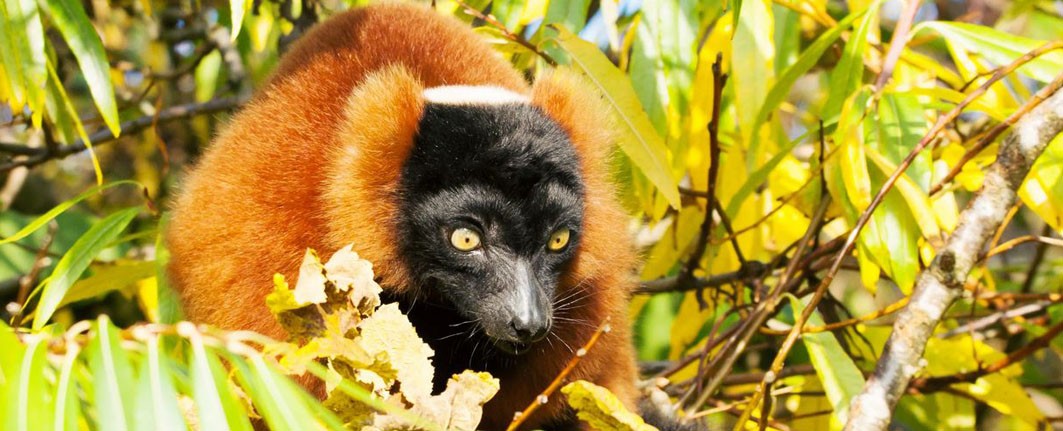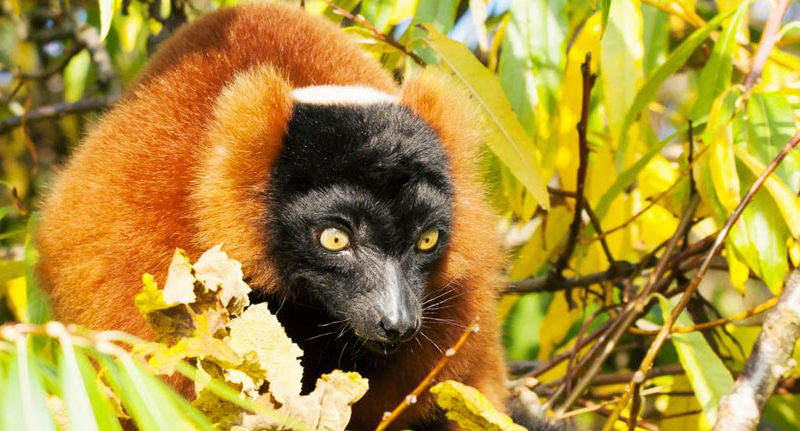
Madagascar Red-bellied Lemur: A Rare Gem of Madagascar’s Eastern Rainforests
The Madagascar Red-bellied Lemur (Eulemur rubriventer) is one of the most captivating primates found in Madagascar’s lush rainforests. Known for its striking facial markings, reddish-brown fur, and elusive behavior, this species has become a highlight for wildlife enthusiasts and eco-tourists. If you’re planning to explore Madagascar’s unique biodiversity, encountering this lemur in its natural habitat is an unforgettable experience.
Distribution of the Madagascar Red-bellied Lemur
The Madagascar Red-bellied Lemur is widespread throughout the eastern rainforests of Madagascar, stretching across various national parks and reserves. Interestingly, it is absent from the Masoala Peninsula, a region otherwise rich in endemic wildlife.
This species thrives in dense, humid forests, where tall canopies and abundant vegetation provide shelter and food. Its distribution reflects the health of Madagascar’s rainforest ecosystems, making it a key species for conservationists studying habitat quality and biodiversity patterns.
Distinctive Identification Features
Recognizing the Madagascar Red-bellied Lemur in the Wild
One of the most striking features of the Madagascar Red-bellied Lemur is its sexual dimorphism—the physical differences between males and females:
-
Males display a rich reddish-brown coat with bold white ‘teardrop’ markings under their eyes.
-
Females, on the other hand, have a paler belly and less pronounced teardrop markings.
Both sexes have black tails and exhibit a more reddish overall coloration compared to other species of brown lemurs. These distinctive traits make it relatively easy for sharp-eyed observers to differentiate this species from others in the forest.
Vocalizations and Communication
The Unique Voice of the Madagascar Red-bellied Lemur
The Madagascar Red-bellied Lemur has a rising, quizzical “whooey” call, reminiscent of the Common Myna bird. In addition to this signature vocalization, the species communicates through quiet grunts and pure, whistled notes, which play a vital role in maintaining group cohesion within dense forest environments.
These calls often help experienced guides and researchers locate groups hidden in the canopy, especially in the early morning when lemurs are most active.
Behavior and Daily Life
The behavior of the Madagascar Red-bellied Lemur closely resembles that of the Brown Lemur. However, this species is generally more retiring, shy, and difficult to observe, preferring to stay in the mid to upper canopy layers.
They are primarily diurnal, most active during the day, feeding on a diet of fruits, leaves, flowers, and occasionally nectar. This dietary flexibility plays a key role in seed dispersal, supporting the regeneration of Madagascar’s rainforests.
Best Places to See the Red-bellied Lemur
Top National Parks for Red-bellied Lemur Sightings
If you’re eager to witness the Red-bellied Lemur in its natural environment, there are a few prime locations to consider:
-
Ranomafana National Park
This is the most reliable destination for spotting the species. Visitors frequently encounter them along the park’s main trails, making it an excellent choice for wildlife photography and guided walks. -
Andasibe-Mantadia National Park
Although Red-bellied Lemurs occur here, they are far less common than in Ranomafana. Sightings require patience, experienced local guides, and sometimes a bit of luck.
These areas offer not only the chance to observe lemurs but also a wide array of birds, reptiles, and endemic plants, making them hotspots for eco-tourism.
Conservation Importance
The Red-bellied Lemur plays an important ecological role as a seed disperser, helping maintain the balance and regeneration of Madagascar’s forest ecosystems. Like many lemur species, it faces threats from habitat loss, deforestation, and hunting. Conservation efforts in protected areas like Ranomafana and Andasibe-Mantadia are essential for the species’ survival.
By visiting these parks responsibly and supporting local conservation initiatives, travelers can directly contribute to the preservation of the Madagascar Red-bellied Lemur and its habitat.
Final Thoughts
Encountering the Red-bellied Lemur is a highlight of any trip to Madagascar. Its unique appearance, melodic calls, and elusive nature make it a symbol of the island’s extraordinary biodiversity. Whether you’re a wildlife photographer, nature lover, or conservation enthusiast, observing this species in the wild is both a privilege and a powerful reminder of the importance of protecting Madagascar’s rainforests.
HT AGENCY TOURS
Luxury Madagascar with the best luxury African safari tours packages. Discover your next perfect destination with HT Agency Tours

